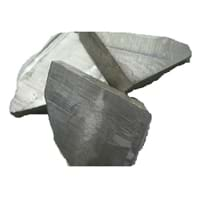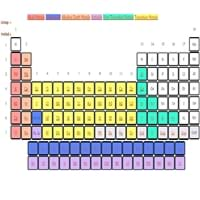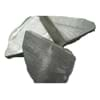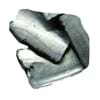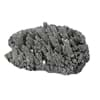Sodium vs Curium
Periodic Table
Symbol
Na
Cm
Group Number
1
17
Not Available
Period Number
3
7
Block
s block
f block
Element Family
Alkali
Actinide
CAS Number
7440235
99+
7440519
36
Space Group Name
Im_ 3m
Not Available
Space Group Number
229.00
1
Not Available
Facts
Interesting Facts
- At room temperature Sodium metal is very soft as it can be chopped down into pieces with butter knife.
- The most common compound of Sodium is NaCl (Salt).
- Curium metal does not occur free in nature.
- Curium metal is a synthetically produced metal.
Sources
By Electrolysis Process, Mining
Bombarding Plutonium with Helium Ions
History
Who Discovered
Humphry Davy
Glenn T. Seaborg, Ralph A. James, Albert Ghiorso
Discovery
In 1807
In 1944
Abundance
Abundance In Universe
2 * 10-3 %
6
Not Available
Abundance In Sun
~0.004 %
6
~-9999 %
Abundance In Meteorites
0.55 %
6
Not Available
Abundance In Earth's Crust
2.30 %
5
Not Available
Abundance In Oceans
1.10 %
1
Not Available
Abundance In Humans
0.14 %
3
Not Available
Uses
Uses & Benefits
- In some nuclear reactors sodium is used as a heat exchanger.
- Compound of Sodium metals called Salt (Sodium chloride) is used in Food.
- Curium metal is used to provide power to electrical equipment for space missions.
Industrial Uses
Electrical Industry, Electronic Industry
NA
Medical Uses
Pharmaceutical Industry
NA
Other Uses
Alloys
Research Purposes
Biological Properties
Toxicity
Toxic
Unknown
Present in Human Body
Yes
No
In Blood
1,970.00 Blood/mg dm-3
1
0.00 Blood/mg dm-3
37
In Bone
10,000.00 p.p.m.
2
0.00 p.p.m.
36
Physical Properties
Melting Point
97.72 °C
99+
1,340.00 °C
34
Boiling Point
883.00 °C
99+
3,110.00 °C
30
Appearance
Physical State
Solid
Solid
Color
Silvery White
Silver
Luster
Metallic
Metallic
Hardness
Mohs Hardness
0.50
22
Not Available
Brinell Hardness
0.69 MPa
99+
Not Available
Speed of Sound
3,200.00 m/s
24
Not Available
Optical Properties
Allotropes
No
No
α Allotropes
Not Available
Not Available
β Allotropes
Not Available
Not Available
γ Allotropes
Not Available
Not Available
Chemical Properties
Chemical Formula
Na
Cm
Isotopes
Known Isotopes
17
22
15
24
Electronegativity
Pauling Electronegativity
0.93
99+
1.30
32
Sanderson Electronegativity
0.56
30
Not Available
Allred Rochow Electronegativity
1.01
35
1.20
27
Mulliken-Jaffe Electronegativity
0.91
21
Not Available
Allen Electronegativity
0.87
99+
Not Available
Electropositivity
Pauling Electropositivity
3.07
6
2.70
22
Ionization Energies
1st Energy Level
495.80 kJ/mol
99+
581.00 kJ/mol
99+
2nd Energy Level
4,562.00 kJ/mol
4
1,196.00 kJ/mol
99+
3rd Energy Level
6,910.30 kJ/mol
6
2,026.00 kJ/mol
99+
4th Energy Level
9,543.00 kJ/mol
5
3,550.00 kJ/mol
99+
5th Energy Level
13,354.00 kJ/mol
4
Not Available
6th Energy Level
16,613.00 kJ/mol
4
Not Available
7th Energy level
20,117.00 kJ/mol
4
Not Available
8th Energy Level
25,496.00 kJ/mol
4
Not Available
9th Energy Level
28,932.00 kJ/mol
4
Not Available
10th Energy Level
141,362.00 kJ/mol
2
Not Available
11th Energy Level
159,076.00 kJ/mol
2
Not Available
Electrochemical Equivalent
0.86 g/amp-hr
99+
3.07 g/amp-hr
16
Electron Work Function
2.75 eV
40
Not Available
Other Chemical Properties
Chemical Stability, Corrosion, Flammability, Ionization, Solubility
Ionization, Radioactive Isotopes
Atomic Properties
Atomic Number
11
99+
96
22
Electron Configuration
[Ne] 3s1
[Rn] 5f7 6d1 7s2
Crystal Structure
Body Centered Cubic (BCC)
Double Hexagonal Close Packed (DHCP)
Crystal Lattice
BCC-Crystal-Structure-.jpg#100
DHCP-Crystal-Structure-of-Curium.jpg#100
Atom
Number of Protons
11
99+
96
22
Number of Neutrons
12
99+
151
10
Number of Electrons
11
99+
96
22
Radius of an Atom
Atomic Radius
186.00 pm
9
174.00 pm
20
Covalent Radius
166.00 pm
27
169.00 pm
26
Van der Waals Radius
227.00 pm
21
200.00 pm
28
Atomic Weight
22.99 amu
99+
247.00 amu
18
Atomic Volume
23.70 cm3/mol
10
18.28 cm3/mol
26
Adjacent Atomic Numbers
Valence Electron Potential
14.10 (-eV)
99+
44.50 (-eV)
38
Lattice Constant
429.06 pm
19
Not Available
Lattice Angles
π/2, π/2, π/2
NA
Lattice C/A Ratio
Not Available
Not Available
Mechanical Properties
Density
Density At Room Temperature
0.97 g/cm3
99+
13.51 g/cm3
25
Density When Liquid (at m.p.)
0.93 g/cm3
99+
13.85 g/cm3
10
Tensile Strength
Not Available
Not Available
Viscosity
Not Available
Not Available
Vapor Pressure
Elasticity properties
Shear Modulus
3.30 GPa
99+
Not Available
Bulk Modulus
6.30 GPa
99+
Not Available
Young's Modulus
10.00 GPa
99+
Not Available
Poisson Ratio
Not Available
Not Available
Other Mechanical Properties
NA
Unknown
Magnetic Properties
Magnetic Characteristics
Specific Gravity
0.97
99+
13.51
17
Magnetic Ordering
Paramagnetic
Antiferromagnetic
Electrical Properties
Electrical Property
Conductor
Unknown
Resistivity
47.70 nΩ·m
99+
1.25 nΩ·m
99+
Electrical Conductivity
0.21 106/cm Ω
9
Not Available
Electron Affinity
52.80 kJ/mol
19
Not Available
Thermal Properties
Specific Heat
1.23 J/(kg K)
3
Not Available
Molar Heat Capacity
28.23 J/mol·K
10
Not Available
Thermal Conductivity
142.00 W/m·K
11
Not Available
Critical Temperature
2,573.00 K
2
Not Available
Thermal Expansion
71.00 µm/(m·K)
4
Not Available
Enthalpy
Enthalpy of Vaporization
89.04 kJ/mol
99+
Not Available
Enthalpy of Fusion
2.59 kJ/mol
99+
15.00 kJ/mol
21
Enthalpy of Atomization
108.40 kJ/mol
99+
Not Available
Standard Molar Entropy
51.30 J/mol.K
28
Not Available
|
||
|
||
|
|
||
|
||
|
